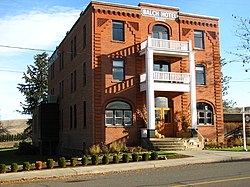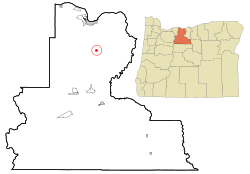Dufur, Oregon
Dufur, Oregon | |
|---|---|
 The Balch Hotel in Dufur | |
 Location in Oregon | |
| Coordinates: 45°27′12″N 121°7′38″W / 45.45333°N 121.12722°W | |
| Country | United States |
| State | Oregon |
| County | Wasco |
| Incorporated | 1893 |
| Government | |
| • Mayor | Merle Keys[1] |
| Area | |
• Total | 0.58 sq mi (1.51 km2) |
| • Land | 0.58 sq mi (1.51 km2) |
| • Water | 0.00 sq mi (0.00 km2) |
| Elevation | 1,345 ft (410 m) |
| Population | |
• Total | 604 |
• Estimate (2019)[4] | 639 |
| • Density | 1,096.05/sq mi (423.16/km2) |
| Time zone | UTC-8 (Pacific) |
| • Summer (DST) | UTC-7 (Pacific) |
| ZIP code | 97021 |
| Area code(s) | 458 and 541 |
| FIPS code | 41-20900[5] |
| GNIS feature ID | 1120201[6] |
| Website | cityofdufur.org |
Dufur is a city in Wasco County, Oregon, United States. The population was 604 at the 2010 census. It is a farming community where wheat, tree fruit, and grapes are important crops.
History
Dufur was incorporated on February 10, 1893,[7] and named after Andrew Dufur and his brother Enoch Burnham Dufur. In 1859 they began raising stock on 600 acres (2.4 km2) of land located where the city now stands.
In 2018, areas of Dufur were evacuated due to three wildfires, the Long Hollow Fire, the Substation Fire, and the South Valley Fire, which burned over 100,000 acres in total.
Geography
According to the United States Census Bureau, the city has a total area of 0.58 square miles (1.50 km2), all of it land.[8]
The hillside letter D can be seen in the northwest. (45°27′29″N 121°08′19″W / 45.458°N 121.1387°W)
Climate
This region experiences warm (but not hot) and dry summers, with no average monthly temperatures above 68 °F. According to the Köppen Climate Classification system, Dufur has a warm-summer Mediterranean climate, abbreviated "Csb" on climate maps.[9]

| Climate data for Dufur | |||||||||||||
|---|---|---|---|---|---|---|---|---|---|---|---|---|---|
| Month | Jan | Feb | Mar | Apr | May | Jun | Jul | Aug | Sep | Oct | Nov | Dec | Year |
| Record high °F (°C) | 70 (21) |
73 (23) |
80 (27) |
90 (32) |
103 (39) |
106 (41) |
110 (43) |
109 (43) |
103 (39) |
92 (33) |
75 (24) |
67 (19) |
110 (43) |
| Mean daily maximum °F (°C) | 39.5 (4.2) |
46 (8) |
54.4 (12.4) |
62.1 (16.7) |
70.4 (21.3) |
77.3 (25.2) |
85.9 (29.9) |
85 (29) |
77 (25) |
63.9 (17.7) |
48.6 (9.2) |
40.5 (4.7) |
62.5 (16.9) |
| Mean daily minimum °F (°C) | 23.8 (−4.6) |
27.1 (−2.7) |
30.9 (−0.6) |
34.3 (1.3) |
39.6 (4.2) |
44.8 (7.1) |
48.8 (9.3) |
48.4 (9.1) |
43.4 (6.3) |
36.4 (2.4) |
30.2 (−1.0) |
25.8 (−3.4) |
36.1 (2.3) |
| Record low °F (°C) | −26 (−32) |
−28 (−33) |
5 (−15) |
16 (−9) |
10 (−12) |
23 (−5) |
31 (−1) |
32 (0) |
17 (−8) |
8 (−13) |
−12 (−24) |
−25 (−32) |
−28 (−33) |
| Average precipitation inches (mm) | 2.01 (51) |
1.4 (36) |
1.09 (28) |
0.81 (21) |
0.86 (22) |
0.68 (17) |
0.24 (6.1) |
0.29 (7.4) |
0.59 (15) |
0.91 (23) |
1.82 (46) |
2.08 (53) |
12.77 (324) |
| Average snowfall inches (cm) | 9.7 (25) |
4.9 (12) |
1.5 (3.8) |
0.1 (0.25) |
0 (0) |
0 (0) |
0 (0) |
0 (0) |
0 (0) |
0.2 (0.51) |
2.8 (7.1) |
7.6 (19) |
26.7 (68) |
| Average precipitation days | 12 | 10 | 9 | 7 | 6 | 5 | 2 | 2 | 4 | 7 | 11 | 12 | 87 |
| Source: [10] | |||||||||||||
Demographics
| Census | Pop. | Note | %± |
|---|---|---|---|
| 1900 | 336 | — | |
| 1910 | 523 | 55.7% | |
| 1920 | 533 | 1.9% | |
| 1930 | 382 | −28.3% | |
| 1940 | 392 | 2.6% | |
| 1950 | 422 | 7.7% | |
| 1960 | 488 | 15.6% | |
| 1970 | 493 | 1.0% | |
| 1980 | 560 | 13.6% | |
| 1990 | 527 | −5.9% | |
| 2000 | 588 | 11.6% | |
| 2010 | 604 | 2.7% | |
| 2019 (est.) | 639 | [4] | 5.8% |
| U.S. Decennial Census[11] | |||

2010 census
As of the census[3] of 2010, there were 604 people, 244 households, and 163 families living in the city. The population density was 1,041.4 inhabitants per square mile (402.1/km2). There were 263 housing units at an average density of 453.4 per square mile (175.1/km2). The racial makeup of the city was 94.5% White, 1.7% Native American, 0.2% Asian, 0.2% Pacific Islander, 1.3% from other races, and 2.2% from two or more races. Hispanic or Latino of any race were 1.5% of the population.
There were 244 households, of which 33.2% had children under the age of 18 living with them, 55.7% were married couples living together, 7.8% had a female householder with no husband present, 3.3% had a male householder with no wife present, and 33.2% were non-families. 29.5% of all households were made up of individuals, and 14% had someone living alone who was 65 years of age or older. The average household size was 2.47 and the average family size was 3.04.
The median age in the city was 42.6 years. 26.2% of residents were under the age of 18; 5.9% were between the ages of 18 and 24; 20.2% were from 25 to 44; 27.1% were from 45 to 64; and 20.5% were 65 years of age or older. The gender makeup of the city was 50.2% male and 49.8% female.
2000 census
As of the census[5] of 2000, there were 588 people, 244 households, and 173 families living in the city. The population density was 1,007.5 people per square mile (391.4/km2). There were 265 housing units at an average density of 454.1 per square mile (176.4/km2). The racial makeup of the city was 97.45% White, 0.68% Native American, 0.34% from other races, and 1.53% from two or more races. Hispanic or Latino of any race were 1.36% of the population.
There were 244 households, out of which 32.0% had children under the age of 18 living with them, 57.8% were married couples living together, 8.2% had a female householder with no husband present, and 28.7% were non-families. 26.2% of all households were made up of individuals, and 11.9% had someone living alone who was 65 years of age or older. The average household size was 2.41 and the average family size was 2.89.
In the city, the population was spread out, with 26.5% under the age of 18, 4.4% from 18 to 24, 21.9% from 25 to 44, 28.4% from 45 to 64, and 18.7% who were 65 years of age or older. The median age was 43 years. For every 100 females, there were 103.5 males. For every 100 females age 18 and over, there were 102.8 males.
The median income for a household in the city was $37,500, and the median income for a family was $41,667. Males had a median income of $34,375 versus $19,792 for females. The per capita income for the city was $17,615. About 5.2% of families and 8.3% of the population were below the poverty line, including 10.4% of those under age 18 and 7.5% of those age 65 or over.
Culture
On the second full weekend of August, Dufur holds its annual Threshing Bee, a harvest festival celebrating the local agricultural economy. The festival includes demonstrations of horse-drawn harvesting equipment, and a steam tractor that powers a belt-driven threshing machine.
Notable people
- Shemia Fagan, Oregon Secretary of State, former Oregon State Representative and State Senator
See also
References
- ^ "City Council". City of Dufur. March 23, 2021. Archived from the original on 2021-05-06.
- ^ "2019 U.S. Gazetteer Files". United States Census Bureau. Retrieved July 28, 2020.
- ^ a b "U.S. Census website". United States Census Bureau. Retrieved 2012-12-21.
- ^ a b "Population and Housing Unit Estimates". United States Census Bureau. May 24, 2020. Retrieved May 27, 2020.
- ^ a b "U.S. Census website". United States Census Bureau. Retrieved 2008-01-31.
- ^ "US Board on Geographic Names". United States Geological Survey. 2007-10-25. Retrieved 2008-01-31.
- ^ Leeds, W. H. (1899). "Special Laws". The State of Oregon General and Special Laws and Joint Resolutions and Memorials Enacted and Adopted by the Twentieth Regular Session of the Legislative Assembly. Salem, Oregon: State Printer: 1055.
- ^ "US Gazetteer files 2010". United States Census Bureau. Archived from the original on 2012-07-02. Retrieved 2012-12-21.
- ^ Climate Summary for Dufur, Oregon
- ^ "DUFUR, OR (352440)". Western Regional Climate Center. Retrieved November 23, 2015.
- ^ "Census of Population and Housing". Census.gov. Retrieved June 4, 2015.
External links
- Entry for Dufur in the Oregon Blue Book
- Zopf, Nancy. "Dufur". The Oregon Encyclopedia.
- Why Dufur? Video produced by Oregon Field Guide

